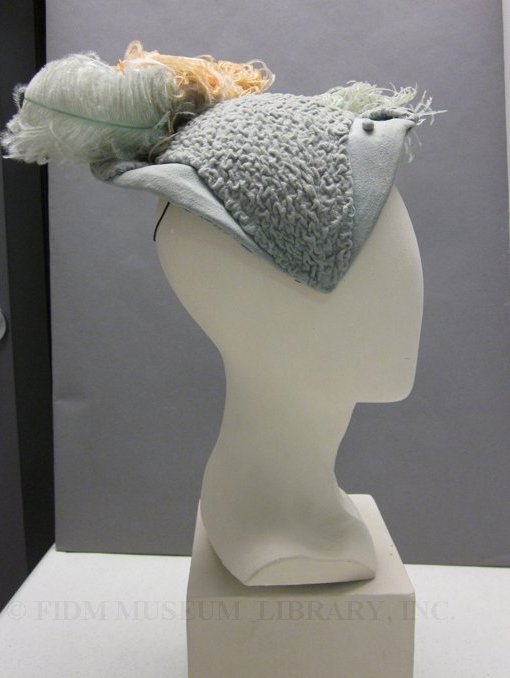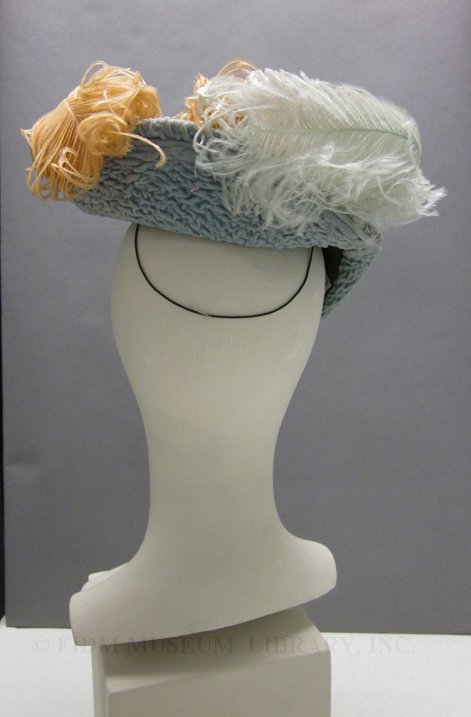Movie Modes hat
During the 1930s, Hollywood films were a major influence on fashion. Movie screens were "huge, luminous shop windows," offering viewers an opportunity to browse the latest creations from talented costume designers.1 Despite the Depression, films were an affordable form of entertainment; during the 1930s, many movie theatres showed a double-feature, cartoon and newsreel for only 10 cents.2 Recognizing that the public wanted to escape their problems, movie studios usually sidestepped the economic and social troubles of the decade, instead producing comedies, westerns and grandiose musicals. Designed by the likes of Adrian, Howard Greer and Edith Head, onscreen fashions inspired the fashion choices of both sophisticated urban women and midwestern farm girls. Believing that women filled the majority of theatre seats, Hollywood studios seized on fashion tie-ins as a means to promote their films.

Hat
Movie Modes
1935-1941
Museum Purchase
2009.5.48AB
Studio publicity departments frequently had one employee charged with disseminating fashion and beauty information to newspapers and magazines. Fan publications like Photoplay and Modern Cinema published numerous articles describing the on and off-screen style of popular cinematic icons. As early as 1930, Bernard Waldman's Modern Merchandising Bureau acted as a corporate middleman between film studios and clothing manufacturers. Studios provided the Bureau with sketches of specific costumes well in advance of a film's release. The sketches were then translated into production designs that were manufactured and released to coincide with a film's premiere. Promotional materials for these designs always included information on the film that inspired the design.
Waldman soon opened a series of Cinema Fashion boutiques to retail garments and accessories inspired by Hollywood costume design. Other cinema-inspired fashion lines soon followed. Beginning in 1931, Hollywood Fashions offered a line of mid-priced designs based on the work of various costume designers, including Howard Greer and Travis Banton. Warner Brothers established Studio Styles in 1934, a brand featuring licensed designs by their costume designers, including hats designed by Orry-Kelly.
This hat from our collection bears a label reading "ORIGINAL Movie Modes featuring 20th Century-Fox Stars." Initial research found no information on "Movie Modes" hats, though the label clearly indicates that the brand was affiliated with 20th Century Fox. Was the hat created by one of their costume designers? Or was it a licensed product? 20th Century Fox was formed during a 1935 merger, so we know that the hat must date from sometime after 1935. Because studio films, and thus costume design, turned more somber with the US entry into World War II on December 7, 1941, this hat probably dates from sometime between 1935-1941.
Hats of the 1930s were both fanciful and widely varied. In the second half of the 1930s, hats with angled brims, bows, feathers and veils looked different from every angle, creating dimensional appeal. One of the most notable hats of the decade was Elsa Schiaparelli's 1937-8 shoe hat. The most unusual element of our Movie Modes hat is the texture. A light blue wool was crinkled to resemble astrakhan fur. Dyed ostrich feathers add even more textural interest. The hat is designed to hug one side of the head, but the brim swoops up dramatically in back. A matching hat pin and thin elastic strap would anchor the hat over a sleek 1930s hairstyle. Though this hat is possibly connected to a specific film, it will take more research (i.e. watching a lot of 1930s 20th Century-Fox movies) to pinpoint its inspiration.
1 Berry, Sarah. Screen Style: Fashion and Femininity in 1930s Hollywood. Minneapolis, MN: University of Minnesota Press, 2000: xi.
2 Farrell-Beck, Jane and Jean Parsons. 20th-Century Dress in the United States. New York: Fairchild Publications, Inc., 2007: 90.

